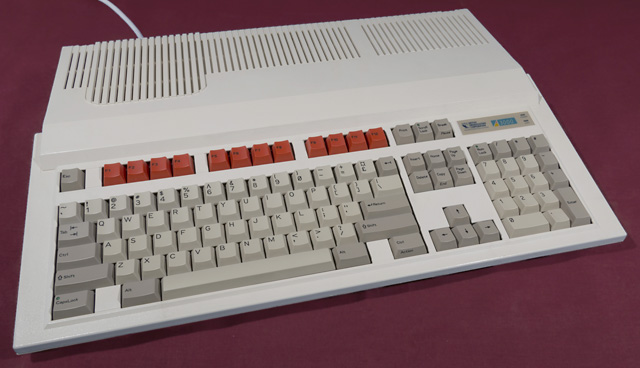Except for its earliest models, Acorn had built its computers around the 6502 microprocessor, which was also used by Apple, Atari, Commodore, and others. Seeing the end of the 8-bit era approaching, Acorn knew that it was time to move to a new architecture. However, the cost of existing 16-bit CPUs was prohibitive, and quite honestly, the efficiency of the 6502 was incredible compared to the Intel 8086, Motorola 68000, and National Semiconductor 32016 (the first 32-bit CPU on the market).
ARM Decides to Make Its Own CPU
Unable to find an existing solution, Acorn decided to adopt the Berkeley RISC concept in a 32-bit processor of its own design, leapfrogging 16-bit completely. The RISC concept is a Reduced Instruction Set Computer, where the CPU would be optimized for a limited set of instructions that it could perform very efficiently. (Most CPUs had many instructions that were rarely used. RISC puts the focus on the most-used instructions.)
The Acorn RISC Machine (ARM) project officially began in October 1983, although advance work had already been done on the RISC concept. The first ARM chip (later known as ARM1) was produced on April 26, 1985, and it worked perfectly the first time it was powered up. The 32-bit ARM1 was used as a co-processor in the BBC Micro to run simulations so the RISC team could design support chips for the new CPU as well as the ARM2 CPU.
Acorn’s First RISC Computers
The first ARM product was the ARM Development System, which was a BBC Master with an ARM as its second CPU. As the name implied, this machine would be used to develop software for Acorn’s forthcoming ARM-only computer.

Acorn Archimedes A3000
The first ARM-based system designed for general use was the Acorn Archimedes, launched in June 1987. The ARM 32-bit CPU had 26-bit addressing and ran at 8 MHz, which is comparable to the 8 MHz 32-bit 68000 CPU with 24-bit addressing used in Apple Macintosh, Atari ST, and Amiga computers.
However, RISC proved itself superior, with Archimedes taking the crown as the fastest microcomputer in the world at the time, able to achieve 18 MIPS (million operations per second). The following table shows how much more efficient ARM2 was per clock cycle than the Intel 80386 and Motorola 68030 of the same period in terms of MIPS – approximately 3x higher than the 80386 and 39% higher than the 68030 per clock cycle.
MIPS Comparison by Instructions Per Clock Cycle (Wikipedia)
ARM CPUs marked in yellow, PowerPC in blue. This table is far from exhaustive.
CPU bits speed MIPS IPCC* Intel 8086 16-bit 5 MHz 0.33 MIPS 0.066 Intel 80286 16-bit 12 MHz 1.28 MIPS 0.107 Intel 80386 32-bit 16 MHz 2.15 MIPS 0.134 Intel 8080 8-bit 2 MHz 0.29 MIPS 0.145 Motorola 68000 32-bit 8 MHz 1.40 MIPS 0.175 TI TMS32010 16-bit 20 MHz 5.00 MIPS 0.250 Motorola 68020 32-bit 16 MHz 4.85 MIPS 0.303 Intel i486DX 32-bit 25 MHz 8.70 MIPS 0.348 Motorola 68030 32-bit 25 MHz 9.00 MIPS 0.360 Motorola 6809 8-bit 1 MHz 0.42 MIPS 0.420 MOS Tech 6502 8-bit 1 MHz 0.43 MIPS 0.430 Motorola 6802 8-bit 1 MHz 0.50 MIPS 0.500 ARM2 32-bit 8 MHz 4.00 MIPS 0.500 RISC ARM7 32-bit 45 MHz 40.00 MIPS 0.889 RISC Intel i860 32-bit 25 MHz 25.00 MIPS 1.000 RISC Motorola 68040 32-bit 40 MHz 44.00 MIPS 1.100 ARM11 32-bit 412 MHz 515.0 MIPS 1.250 RISC PowerPC 603e 32-bit 133 MHz 188.0 MIPS 1.414 RISC Intel Pentium 32-bit 100 MHz 188.0 MIPS 1.880 PowerPC 601 32-bit 80 MHz 157.7 MIPS 1.971 RISC ARM Cortex-A8 32-bit 1.0 GHz 2000.0 MIPS 2.000 RISC PowerPC 750 (G3) 32-bit 233 MHz 525.0 MIPS 2.300 RISC ARM Cortex-A9 32-bit 1.5 GHz 7500.0 MIPS 2.500 RISC Intel Pentium Pro 32-bit 200 MHz 541.0 MIPS 2.700 AMD Athlon 32-bit 1.2 GHz 3561 MIPS 3.000 Intel Pentium 4 32-bit 3.2 GHz 9726 MIPS 3.000 Intel Pentium III 32-bit 600 MHz 2054 MIPS 3.400 AMD Athlon 64 64-bit 2.0 GHz 14564 MIPS 3.600 AMD Athlon XP 32-bit 1.83 GHz 7527 MIPS 4.100 AMD Athlon FX-57 32-bit 2.8 GHz 12000 MIPS 4.300 PA Semi PA6T 64-bit 1.8 GHz 8800 MIPS 4.400 Intel Core 2 Extreme 64-bit 2.93 GHz 27079 MIPS 4.600 * instructions per clock cycle
Because Intel’s most powerful CPUs now incorporate TurboBoost™, they are not included in this table. In some cases an Intel CPU with TurboBoost can operate at nearly twice its nominal speed, making the instructions per clock cycle figure meaningless.
If you have used an Archimedes computer or RiscPC, consider joining the Acorn Archimedes group on Facebook.
Photos by Simon Inns, Creative Commons license, used with his kind permission.
Sources
- A Brief History of ARM Holdings, Daniel Nenni, SemiWiki.com
- Acorn Computers, Wikipedia
keywords: #risc #arm #acorn #archimedes #acornarchimedes
short link: https://goo.gl/X1eBrb

